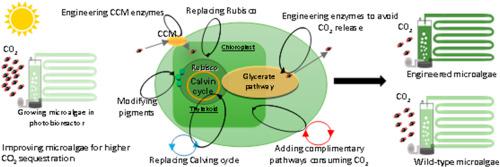Biomass & Bioenergy ( IF 6 ) Pub Date : 2020-12-17 , DOI: 10.1016/j.biombioe.2020.105927 Bahram Barati , Kuo Zeng , Jan Baeyens , Shuang Wang , Min Addy , Sook-Yee Gan , Abd El-Fatah Abomohra

|
Reducing carbon dioxide (CO2) emissions has been a hot research topic in recent years. The integration of microalgae cultivation using CO2 from power plants and factories has been introduced as an environmentally friendly approach. However, strains with high biomass productivity are required to achieve a sustainable integrated platform. Improving photosynthesis is critical to increase both biomass productivity and CO2 sequestration efficiency. The improvement of photosynthesis is often attained by enhancing the efficiency of enzymes that are involved in CO2 fixation, reducing the antenna size to avoid energy loss, extending the photosynthetically active radiation range to broaden the light utilization capacity, increasing CO2 assimilation by replacing the existing carbon fixation pathway with more efficient pathways and enzymes, and reducing the release of captured CO2. Implementation of these modifications is achievable via transformation and gene editing. The transformation of the new gene constructs into microalgae has been discussed as an extremely challenging task in the past decade. In recent studies, the digestion of the microalgae cell wall, as one of the main barriers of transformation, has been recommended as a promising approach. Moreover, the emergence of preassembled Cas9 protein-gRNA ribonucleoproteins that do not require vector constructs has been suggested as an efficient approach for gene editing. This review comprehensively describes the potential strategies that enhance microalgae CO2 fixation, provides insight into current limitations and gaps, and proposes future perspectives.
中文翻译:

转基因微藻增强二氧化碳封存的最新进展
近年来,减少二氧化碳(CO 2)的排放一直是研究的热点。作为一种环境友好的方法,已经引入了整合发电厂和工厂使用CO 2的微藻种植的方法。然而,需要具有高生物量生产力的菌株以实现可持续的整合平台。改善光合作用对提高生物量生产率和CO 2固存效率至关重要。光合作用的改善通常是通过提高参与CO 2固定的酶的效率,减小天线尺寸以避免能量损失,扩大光合有效辐射范围以扩大光利用能力,增加CO来实现的。2同化通过用更有效的途径和酶代替现有的碳固定途径,并减少捕获的CO 2的释放。这些修饰的实现可通过转化和基因编辑来实现。在过去的十年中,已经讨论了将新基因构建体转化为微藻的工作,这是一项极富挑战性的任务。在最近的研究中,已建议将微藻细胞壁的消化作为转化的主要障碍之一,作为一种有前途的方法。而且,预装Cas9的出现已经提出了不需要载体构建体的蛋白-gRNA核糖核蛋白作为基因编辑的有效方法。这篇综述全面地描述了增强微藻CO 2固定的潜在策略,提供了对当前局限性和差距的洞察力,并提出了未来的观点。


























 京公网安备 11010802027423号
京公网安备 11010802027423号